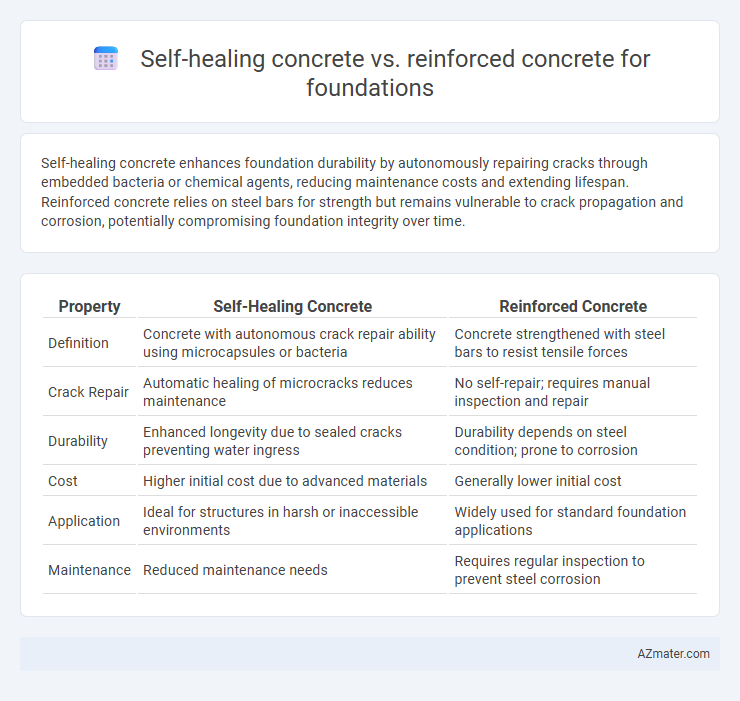Self-healing concrete enhances foundation durability by autonomously repairing cracks through embedded bacteria or chemical agents, reducing maintenance costs and extending lifespan. Reinforced concrete relies on steel bars for strength but remains vulnerable to crack propagation and corrosion, potentially compromising foundation integrity over time.
Table of Comparison
| Property | Self-Healing Concrete | Reinforced Concrete |
|---|---|---|
| Definition | Concrete with autonomous crack repair ability using microcapsules or bacteria | Concrete strengthened with steel bars to resist tensile forces |
| Crack Repair | Automatic healing of microcracks reduces maintenance | No self-repair; requires manual inspection and repair |
| Durability | Enhanced longevity due to sealed cracks preventing water ingress | Durability depends on steel condition; prone to corrosion |
| Cost | Higher initial cost due to advanced materials | Generally lower initial cost |
| Application | Ideal for structures in harsh or inaccessible environments | Widely used for standard foundation applications |
| Maintenance | Reduced maintenance needs | Requires regular inspection to prevent steel corrosion |
Introduction to Self-Healing and Reinforced Concrete
Self-healing concrete incorporates microcapsules or bacteria that react with water to autonomously repair cracks, enhancing durability and reducing maintenance costs in foundations. Reinforced concrete combines concrete with steel rebar to improve tensile strength and structural integrity, widely used for its reliability in foundation support. The integration of self-healing technology aims to extend the lifespan of foundations beyond traditional reinforced concrete by minimizing crack propagation and moisture ingress.
Composition and Material Differences
Self-healing concrete incorporates microcapsules or bacteria that trigger crack repair through chemical reactions, enhancing durability and lifespan, while reinforced concrete relies on steel bars embedded in cement to provide tensile strength and structural support. The composition of self-healing concrete includes polymers, minerals, or microbial agents that initiate autonomous crack sealing, whereas reinforced concrete typically combines Portland cement, aggregates, and steel reinforcement. Material differences impact performance under stress; self-healing concrete reduces maintenance by automatically repairing micro-cracks, whereas reinforced concrete depends on manual repair and corrosion protection of steel elements.
Mechanisms of Crack Management
Self-healing concrete incorporates bacterial spores or encapsulated healing agents that activate when cracks form, producing calcium carbonate or polymer to autonomously seal fissures and restore structural integrity. Reinforced concrete relies on steel reinforcement bars to bear tensile loads and limit crack width, preventing propagation but requiring external maintenance if cracks compromise durability. The self-healing mechanism offers proactive crack repair through biomineralization or chemical reactions, whereas reinforced concrete primarily manages cracks by mechanical restraint and passive durability enhancement.
Durability and Longevity
Self-healing concrete significantly enhances durability and longevity in foundation applications by autonomously repairing microcracks, thereby preventing water infiltration and corrosion of reinforcement. Reinforced concrete, while strong initially, is prone to crack propagation and reinforcement corrosion over time, leading to reduced structural integrity and increased maintenance costs. The integration of self-healing agents in concrete matrices extends the service life of foundations, making them more resilient to environmental stressors and reducing lifecycle expenses.
Cost Analysis and Economic Impact
Self-healing concrete reduces long-term maintenance and repair costs by autonomously sealing cracks, potentially lowering life-cycle expenses compared to traditional reinforced concrete. Reinforced concrete requires periodic inspections and costly repairs due to crack propagation, impacting overall project budgets. Initial costs of self-healing concrete are higher, but economic impact favors its use in foundation applications for infrastructure with extended service life expectations.
Environmental Sustainability Considerations
Self-healing concrete enhances environmental sustainability by reducing maintenance frequency and extending the lifespan of foundation structures, thereby minimizing resource consumption and waste generation compared to traditional reinforced concrete. Reinforced concrete often requires significant repair interventions due to cracking and corrosion, leading to higher carbon emissions associated with material production and construction activities. The integration of self-healing agents in concrete supports durability and lowers the ecological footprint of foundations, promoting sustainable construction practices aligned with green building standards.
Structural Performance in Foundations
Self-healing concrete enhances structural performance in foundations by autonomously repairing cracks, reducing maintenance costs and extending service life compared to traditional reinforced concrete. Reinforced concrete relies on steel reinforcement to provide tensile strength but remains vulnerable to corrosion and crack propagation, which can compromise foundation integrity over time. The integration of self-healing agents in concrete matrices improves durability and load-bearing capacity, making it a superior option for long-term foundational stability.
Maintenance and Repair Requirements
Self-healing concrete significantly reduces maintenance and repair requirements by autonomously sealing microcracks and preventing water ingress, thereby enhancing durability in foundations. Reinforced concrete typically demands regular inspections and repairs due to crack propagation and steel corrosion risks, increasing lifecycle maintenance costs. Employing self-healing concrete in foundations minimizes downtime and extends structural service life compared to conventional reinforced concrete.
Real-World Applications and Case Studies
Self-healing concrete, enhanced with microcapsules or bacteria to autonomously repair cracks, has been successfully deployed in infrastructure projects like the Netherlands' waterways to extend foundation lifespan and reduce maintenance costs compared to traditional reinforced concrete. Reinforced concrete, widely used due to its proven high compressive and tensile strength, remains the standard for foundational structures in skyscrapers and bridges but often requires costly repairs from crack propagation and corrosion of steel rebar. Case studies from highway overpasses in Japan demonstrate self-healing concrete reducing crack width by up to 80%, indicating significant durability improvements in harsh environmental conditions over standard reinforced concrete foundations.
Future Potential and Innovations in Concrete Technology
Self-healing concrete offers transformative potential for foundation durability by autonomously repairing micro-cracks, significantly extending structure lifespan and reducing maintenance costs compared to traditional reinforced concrete. Innovations like encapsulated bacteria and microcapsules embedded in the concrete matrix enable this smart material to respond to damage without human intervention, aligning with sustainable construction goals. As research progresses, integrating self-healing agents with advanced reinforcement techniques could redefine foundation resilience and lifecycle performance in modern infrastructure.

Infographic: Self-healing concrete vs Reinforced concrete for Foundation
 azmater.com
azmater.com